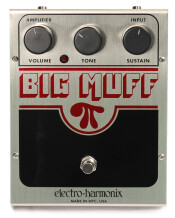Diode mods: The Muff contains 4 diodes, 2 pairs, in a known orientation that clipping and compression occur. Changing these diodes result in the change of the overal sound. Some examples:
-
Silicon diodes; normally, the Muff will contain 4x 1N4148 diodes (or similar devices). These silicon diodes provide smooth, tight compression and are used here as a reference value.
-
The 2006 NYC reissue models use 1N6263 silicium Schottky diodes. These diodes cut the sound less then stock silicons and add a bit less compression. Result: sound is less compressed, louder, tighter and will lean more to the treble side. Nice new approach to the muff sound.
-
Germanium diodes; germanium diodes cut the sound more and add a tad more compression to the sound. Result: sound is less loud, more compressed and a bit more gainy.Sometimes an octave effect can be heard. No germanium diodes were used in original Muffs.
-
LED's; LED's are also simple diodes. In the Muff they cut the sound even less then the Schottky's and add less compression. Result: more volume, less compression / less gain.
-
FET's / MOSFET's; these units can also be used as diodes when the drain and the gate are taken together. Sound is similar to silicons only a bit more smoother
-
No diodes; great trick! By removing the diodes from the unit no sound if fed back. Result: more volume (LOUD!), less compression, less gain and a more open (overdrive) sound. By removing only the first two diodes (of the first stage) the bass response of the unit will become much greater when Sustain increases (great for bass players!). This trick is also done to the Colorsound Supa Tonebender, which is basically a Muff with the first diodes removed.
Small addition: as the unit uses a pair of diodes you can experiment with different diodes per pair to get more complex sounds, nice touches or just "YOUR" sound! Any diode will work here, properly orientated.
Les diodes sont identifiés par les numéros D1/D2/D3 et D4.
Proviens du site: http://rkerkhof.ruhosting.nl/Taas/Mods/Big%20Muff.htm
Avez-vous trouvé ce tutoriel utile ?20
Soyez le premier à réagir à ce tutoriel










